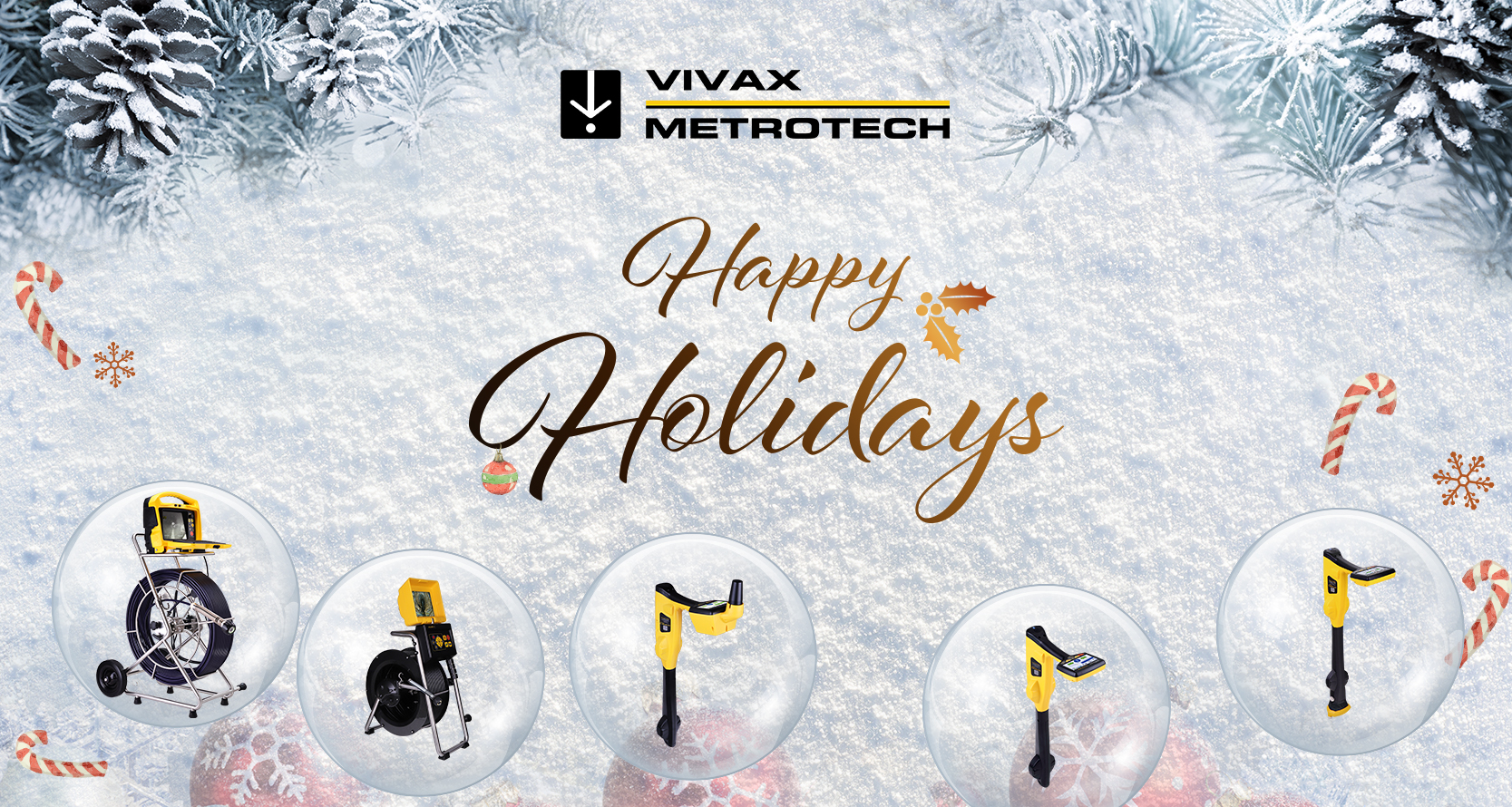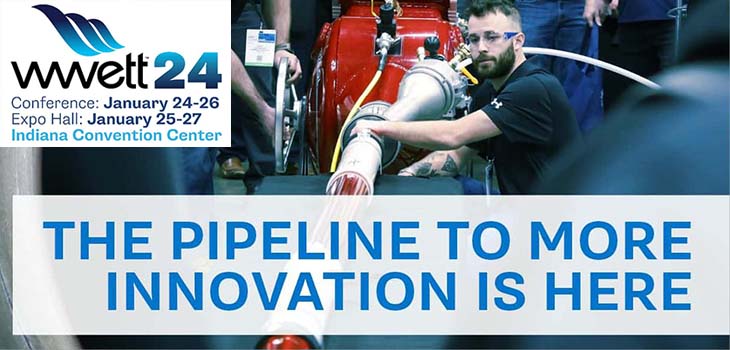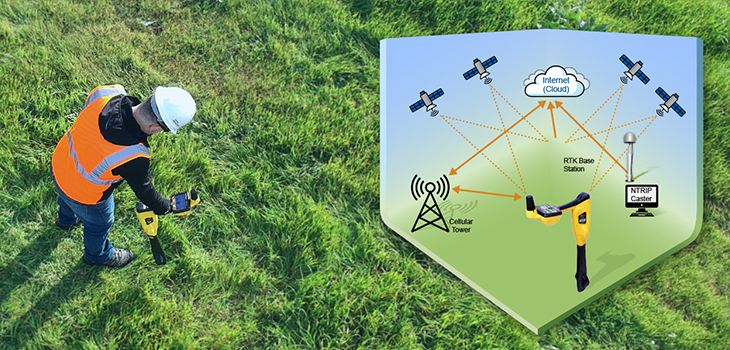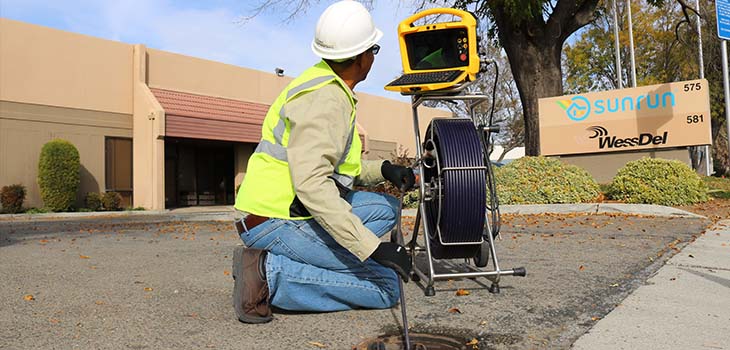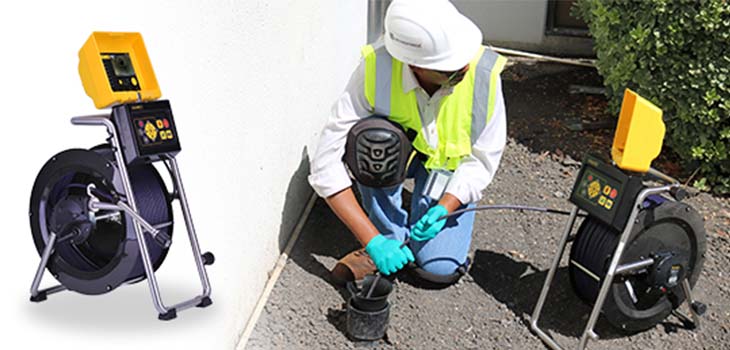Download Categories
FAQs
FAQ
How deep you can locate buried utilities depends on the model of the locator, the strength of the signal being detected, ground conditions and the condition of the utility. Under good conditions, the below can be achieved.
- General locating - up to 15-feet
- Sondes - up to 9-feet (using 512Hz/640Hz Sonde in a cast iron pipe)
- Sonde - up to 15-feet (using 33kHz Sonde in a non metallic pipe)
A locator with a single horizontal antenna can be used using the "70% method". First, pinpoint the target line and set the locator sensitivity to show a reading of 100% or full-scale deflection (fsd). Keeping the locator close to the ground, move it to the left and right until the meter reading reduces to 70% of fsd and mark these points. The distance between these two points will be twice the depth to the center of the target line.
Yes, most locator models (except the 480 series) can measure the depth to a target line. The locator utilizes two horizontal antennas to measure depth in the same way our two eyes can judge distance. The strength of the signals on these two horizontal antennas is compared, and the system software uses this to calculate the depth electronically and indicate the reading on the display. With the VB-480B Locator, you can estimate depth measurement using the triangulation method (see Page 12 of the VM-480B user manual).
The best place to measure the depth on the target line is on a straight utility section. You do not want to take depth measurements at tees, bends, or significant changes in depth. If you must measure depth in the vicinity of these areas, try to do so at least ten paces away from the area to minimize any effects from signal distortion. Also, never measure the depth to a target line within thirty paces of a transmitter operating in the induction mode.
As a general rule, the depth measurement accuracy is 5% of actual depth.
The vLoc series locators have a current measurement feature that can assist the user to correctly identifying a target cable. This feature works much the same way as depth calculation. This feature is also helpful to determine how much signal there is at a given point, which can assist in fault location and understand how much signal is left on the target line.
As a general rule, the current measurement accuracy is 5% of the actual current.
The Power and Radio modes are considered passive signals; these signals are often present "naturally" on buried metallic utilities. They provide a convenient means of searching for these utilities without the need to connect a transmitter. Loaded power cables radiate 50/60 Hz energy that the receiver can detect in Power mode. However, power signals may also be present on other cables and metallic pipes due to coupling. Longwave radio transmissions penetrate the ground and cause radio frequency currents to travel along with metallic utilities, and these can be detected with the Radio mode. Passive signals should never be used for identifying the line being located.
An active signal is generated by a signal transmitter at a specific frequency and imposed onto the target line through a direct connection, use of a signal clamp, or induction. An active signal allows the user to target a specific cable or pipe, pinpoint its position, measure depth and current and trace the route.
As the name suggests, a direct connection is simply that; the output from the transmitter is connected directly to the target line. Induction, on the other hand, is based on the principle of electromagnetic induction. The transmitter has an internal coil of wire that, when energized, produces an electromagnetic field (at a given frequency) which will induce or couple to any metallic line the transmitter is placed over. Direct connection is the first choice for signal application as this method utilizes lower frequencies. This reduces the risk of signal coupling to adjacent metallic lines, and the signal will travel further along the target line. However, in cases where direct connection is not possible, induction is a suitable method of applying the transmitter signal.
To understand signal distortion and how it affects the locate, it is essential first to understand that when locating cables and pipes, the locator is not detecting a cable or pipe, but rather the electromagnetic field, active or passive, that radiates from them. Therefore, anything that affects this electromagnetic field, and there can be many reasons, can, in turn, affect the locate position and depth measurement.
Yes, however, this is not the recommended method; direct connection is. Paying close attention to the receiver's signal strength will ensure an accurate locate can be achieved.
This most frequently asked question is one locator manufacturers try to avoid answering. A detailed explanation is required to appreciate why this is. The rate of signal loss on any given line is a function of its electrical characteristics, i.e., conductivity, capacitance and inductance relative to the ground and other adjacent metallic lines.
Factors that affect locate distance include:
- Frequency being used
- Condition of the target line
- Soil conditions
- Effects of signal coupling
- Sensitivity of the receiver
- Signal current on the line
- Depth of the utility
Directly to the target cable or pipe you wish to locate. Use the safest connection point offering a good metal connection, i.e., valves, bolts, armoring etc. Remember that the ground stake is the safest grounding option. Never ground to any metallic structure with an above-ground or below-ground structure as it will sometimes radiate the locate signal better than the line being located.
No, the chargers are not designed to supply power for locating. On some models, a separate power lead is available (as an option) so that the transmitter can be powered from a vehicle. Do not try to make one using the charging plug – the wiring configuration is different from that of the charger.
Unwanted coupling of the signal is one of the most common locating problems, increasing errors in the locate position or depth of the target line due to distortion and often leading to the marking of the wrong line.
To minimize these unwanted effects, ensure:
- Avoid applying the signal using induction; use a direct connection or a signal clamp where possible
- Use the lowest frequency possible for the given method of signal application
- Use the minimum power output that can be detected
- Avoid applying the signal in congested areas
- Extend the ground stake as far from the connection point as possible
- Avoid using structures for grounding, as other services may be bonded to them
- Use double-ended connections to by-pass the ground return
There are several actions you can take to improve the grounding of the transmitter signal in poor soil conditions.
- Pour water around the ground stake.
- Try moving it to an area where more moisture is present.
- Running an "extension" cable from the transmitter earth (black) lead to a nearby road sign or other similar metal objects that may increase your signal.
The cable must be grounded at both ends for a successful locate when using a signal clamp.
No, it depends on the type of cores used in the clamps – in the case of most clamps, they are designed to have a gap, roughly the thickness of a business card, and maybe cleaned by using a business card as a gauge. The vLoc clamps use a different material, and there should be no gap on those.
Rebar is the common name for the metal bars used to reinforce the concrete structure. When locating over an area containing rebar, the locate signal may lose clarity or spread across a wide area. If this happens, then the rebar is to blame. To check, raise the locator by about 0.5m (18-inches) or knee level and reduce the sensitivity; this should clear or minimize any effect from the rebar.
Generally, it is not possible to locate non-conducting or non-metallic lines with ordinary pipe & cable locators on their own. However, many utility companies install tracer wire above or alongside their non-metallic services, usually located. For non-metallic drains, ducts and pipes, these can be located with the aid of a Sonde, or in the case of the CCTV inspection cameras, a Sonde is frequently built into them just behind the camera head.
Sondes small battery-powered transmitters inserted and propelled into pipes, drains, or ducts and are located on the surface by a sonde locator or utility locator what a sonde mode. The receiver must have a "Sonde" mode that includes a separate Sonde depth measurements algorithm to read the depth to a sonde.
The majority of camera systems have a built-in 512 or 640Hz sonde. If not, one can be attached to the camera pushrod behind the camera head. If inspecting a cast iron pipe, use a 512Hz or 640Hz sonde. If inspecting a non-metallic pipe, a 33 kHz will work.
Low-frequency Sondes operating at 512 Hz or 640Hz can be used in cast iron pipes and detected at depth ranges of up to 3m. Sondes cannot be used in ductile iron or steel pipes.
No, Vivax-Metrotech locators are explicitly designed for the detection, location and tracing of buried utilities.
The batteries used will depend on the model of the locator's receiver and transmitter. All alkaline batteries used in our locators are standard off-the-shelf batteries such as AA, C cells, D cell, PP9 batteries (smoke detector batteries). The smaller sondes may use button-style batteries similar to those used in watches and small calculators. All of our rechargeable packs are sealed and should never be opened. Replacement rechargeable packs should be bought from Vivax-Metrotech or a regional repair center.
Please note that:
- Rechargeable batteries may vary in different locator models, and receiver batteries will be different from transmitter batteries.
- The correct battery charger must be used to avoid damage to the unit, possible harm to the operator, or start a fire in the worst case.
- Battery chargers frequently contain electronics that govern the rate of charge even if the voltage, polarity and current rating are the same. Other chargers could cause damage to the unit, possible harm to the operator, or start a fire in the worst case.
- Never dispose of any types of batteries in a fire.
- Always dispose of batteries responsibly and follow your company's policy for battery disposal.
- Beware that there are shipping regulations regarding the shipping of batteries & battery packs, specifically Lithium-Ion. Check with your carrier before shipment, or call Vivax-Metrotech for guidance.
- Do not turn any battery charger on/off repeatedly when charging. Each time the unit is turned off/on, the charging cycle starts again. This could result in overcharging and shortening the life of the rechargeable batteries. In extreme cases, it could result in overheating or fire.
- Always use the locator before charging again.
Check the batteries, all associated cables and clamps, and ensure everything operates as described in the user manual. In addition, having a known test site helps determine if the instrument is working correctly.
We recommend that you try changing the batteries and checking the conductive attachment leads. A qualified Metrotech Repair Center should perform any other repairs.
Do not use solvents for cleaning. If it is necessary to remove mud or grime, use a sponge dampened with warm water. A mild soap may be used to loosen ingrained dirt. Periodically wipe the display window with an anti-static fluid. Do not immerse the receiver or transmitter in any liquid during cleaning.
Please visit the Contact Us page on our website. It has addresses and contact numbers for all our locations as well as our authorized service centers.
No, we do not require RMA #'s, but we request that you include your PO# or preferred payment method, name, contact phone #, symptoms if known, `ship to` street address and `bill to address. Please indicate if an estimate is required, pre-approved limit or priority service is required. On our website, in the Support option, you can find a Service Center Request form. You can fill in this form online and then print it to put in the box along with your product for repair.
There is no charge for priority repair service other than related shipping costs, such as overnight instead of ground.
If the dealer you purchased the Vivax-Metrotech locator from has a service center, contact them.
Check our website for the nearest repair center.
Vivax-Metrotech Corporation
3251 Olcott Street, Santa Clara CA 95054
1-800-638-7682



